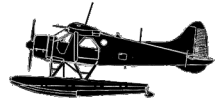
ASN Wikibase Occurrence # 41204
This information is added by users of ASN. Neither ASN nor the Flight Safety Foundation are responsible for the completeness or correctness of this information.
If you feel this information is incomplete or incorrect, you can submit corrected information.
| Date: | Wednesday 9 September 1998 |
| Time: | 10:45 |
| Type: |  de Havilland Canada DHC-2 Beaver |
| Owner/operator: | Rust's Flying Service Inc |
| Registration: | N1433Z |
| MSN: | 595/1345 |
| Year of manufacture: | 1953 |
| Total airframe hrs: | 12948 hours |
| Fatalities: | Fatalities: 5 / Occupants: 5 |
| Aircraft damage: | Substantial |
| Category: | Accident |
| Location: | near Telequana Pass, AK -
 United States of America United States of America
|
| Phase: | En route |
| Nature: | Passenger - Non-Scheduled/charter/Air Taxi |
| Departure airport: | Lake Hood Seaplane Base, AK (LHD) |
| Hoholitna River, AK | |
| Investigating agency: | NTSB |
| Confidence Rating: |
On September 9, 1998, about 1045 Alaska daylight time, a Dehavilland DHC-2, float equipped airplane, N1433Z, sustained substantial damage when it impacted mountainous terrain about 3,600 feet msl near Telequana Pass, Alaska. The pass is about 48 miles north-northwest of Port Alsworth, Alaska. The commercial pilot and the four passengers sustained fatal injuries. The flight was operated by Rust's Flying Service, Inc., of Anchorage, Alaska. The flight was conducted under 14 CFR Part 135 as an on-demand air taxi transporting hunters from the Lake Hood seaplane base in Anchorage, to a hunting lodge on the Hoholitna River, about 190 miles west of Anchorage. Visual meteorological conditions prevailed at the time of the accident, and a company VFR flight plan was in effect.
The float equipped airplane was attempting to cross a mountain pass, following two other company airplanes. The first two pilots, and passengers, described five to seven miles visibility, 700 feet ceilings, clouds hanging on the mountainsides, and misty rain. The route of flight required several turns in the pass. The pilot had not flown through the pass in marginal Visual Flight Rules (VFR) weather before this flight. After the first two airplanes went through the pass, they lost radio contact with the accident pilot, and did not see or hear from him again. The wreckage was later located at the head of an intersecting canyon, two miles before the correct pass. The airplane had been modified with a Short Take Off and Landing (STOL) kit. Canadian certification flight tests had determined that this modification eliminated aerodynamic warning of impending stalls, and therefore required an audible stall warning. Company pilots indicated it was common for the stall warning system to activate at an airspeed 10-15 miles per hour above the actual stall. At the time of the accident, the airplane did not have the ventral fin installed, and a takeoff flaps setting was selected. The audible stall warning circuit breaker was found in the pulled (disabled) position.
Probable Cause: The pilot's failure to maintain adequate airspeed which resulted in an inadvertent stall. Factors associated with this accident were the pilot's unfamiliarity with the geographic area, the low clouds, his becoming disoriented, and the blind canyon into which he flew. An additional factor was the intentionally disabled stall warning system.
Accident investigation:
 |
|
Sources:
https://www.ntsb.gov/_layouts/ntsb.aviation/brief.aspx?ev_id=20001211X10967&key=1
http://www.dhc-2.com/id732.htm
Images:

Photo: NTSB
Revision history:
| Date/time | Contributor | Updates |
|---|---|---|
| 24-Oct-2008 10:30 | ASN archive | Added |
| 14-Aug-2011 11:24 | TB | Updated [Cn, Operator, Source] |
| 21-Dec-2016 19:23 | ASN Update Bot | Updated [Time, Damage, Category, Investigating agency] |
| 21-Oct-2017 14:51 | TB | Updated [Source] |
| 13-Oct-2022 10:37 | Captain Adam | Updated [Operator, Location, Nature, Departure airport, Narrative, Accident report, Photo] |
Corrections or additions? ... Edit this accident description
The Aviation Safety Network is an exclusive service provided by:


 ©2024 Flight Safety Foundation
©2024 Flight Safety Foundation